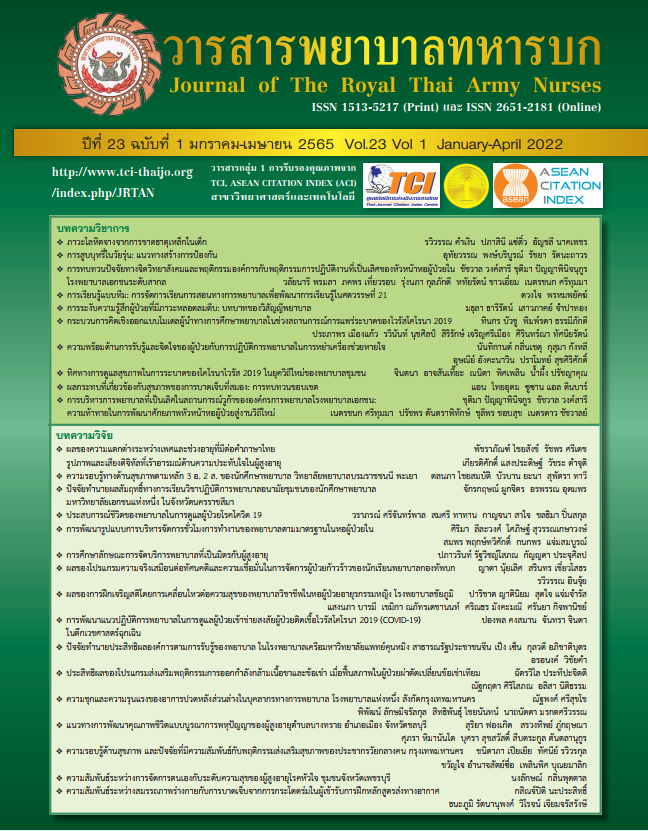The Relationship between The Physical Fitness and Injuries among the Participants of Basic Air Borne Course
Keywords:
Physical fitness, Injuries, Basic airborne courseAbstract
The Objective of this study was to investigate the association between baseline physical fitness level and military static-line parachute injuries in basic airborne trainees of the Special warfare school. A prospective cohort study was conducted among 1,375 military personnel who attended the airborne training program of the Royal Thai Army during 2020. Data about 5 physical fitness tests (2-mile running, 2-minute sit up and push up, pull up, and 100-meter swimming), personal demographics and health histories were collected at baseline, while the occurrence of static-line parachute injuries were observed during five rounds of parachute jump after the ground training. Associations between baseline physical fitness tests and subsequent parachute injury were determined by analyzing Multi-level Poisson Regression and using the Incidence Rate Ratio (IRR) and 95% confidence interval (95%CI) as the risk measure.
Result showed that the incidence rate of parachute injury was 34.40 per 1,000 jumps (95%CI: 30.16-39.24). Lower level of 2-mile running capacity was significantly related to the injury [Adjusted IRR (95%CI): 1.75 (1.52-2.00)]. Conclusion, Baseline running fitness level associate with military static-line parachute injuries in basic airborne trainees.
Downloads
References
Maneechaeye W, Jiamjarasrangsi W, Deepreecha K. Incidence and associated factors of military static line parachute injuries in basic airborne trainees. Royal Thai Army Medical Journal. 2019;72(1):21-31. (In Thai)
Hughes CD, Weinrauch PC. Military static line parachute injuries in an Australian commando battalion. ANZ J Surg. 2008;78(10):848-52.
Knapik JJ, Steelman R, Grier T, Graham B, Hoedebecke K, Rankin S, et al. Military parachuting injuries, associated events, and injury risk factors. Aviat Space Environ Med. 2011;82(8):797-804.
Hughes CD, Weinrauch PC. Military static line parachute injuries in an Australian commando battalion. ANZ J Surg. 2008;78:848-52
Kiel FW. Hazards of military parachuting. Mil Med. 1965; 130:512-21.
Farrow GB. Military static line parachute injuries. Aust N Z J Surg. 1992; 62:209-14
Knapik JJ, Spiess A, Swedler D, Grier T, Darakjy S, Amoroso P, et al. Injury risk factors in parachuting and acceptability of the parachute ankle brace. Aviat Space Environ Med. 2008; 79(7):689-94.
Knapik J, Steelman R. Risk factors for injuries during military static-line airborne operations: a systematic review and meta-analysis. J Athl Training. 2016;51(11):962-80.
Knapik J, Spiess A, Darakjy S, Grier T, Manning F, Livingston E, et al. Risk factors for parachute injuries and airborne student observations on the parachute ankle brace. U.S. Army Center for Health Promotion and Preventive Medicine; 2007. Contract No.: 12-MA01Q2-08B.
Lisman P, O’Connor FG, Deuster PA, Knapik JJ. Functional movement screen and aerobic fitness predict injuries in military training. Med Sci Sports Exerc. 2013;45(4):636-43.
Zakowski B, Wagner-Olszewska I, Domzalski M. Analysis of a military parachutist injury-a retrospective review of over 37,000 landings. Mil Med. 2019;184(1-2):E261-E5
Knapik JJ, Spiess A, Swedler D, Grier T, Hauret K, Yoder J, et al. Retrospective examination of injuries and physical fitness during Federal Bureau of Investigation new agent training. J Occup Med Toxicol. 2011;6:26.
Lisman PJ, de la Motte SJ, Gribbin TC, Jaffin DP, Murphy K, Deuster PA. A systematic review of the association between physical fitness and musculoskeletal injury risk: part 1-cardiorespiratory endurance. J Strength Cond Res. 2017 Jun;31(6):1744-57.
Downloads
Published
How to Cite
Issue
Section
License
Copyright (c) 2022 Journal of The Royal Thai Army Nurses

This work is licensed under a Creative Commons Attribution-NonCommercial-NoDerivatives 4.0 International License.
บทความหรือข้อคิดเห็นใดใดที่ปรากฏในวารสารพยาบาลทหารบกเป็นวรรณกรรมของผู้เขียน ซึ่งบรรณาธิการหรือสมาคมพยาบาลทหารบก ไม่จำเป็นต้องเห็นด้วย
บทความที่ได้รับการตีพิมพ์เป็นลิขสิทธิ์ของวารสารพยาบาลทหารบก
The ideas and opinions expressed in the Journal of The Royal Thai Army Nurses are those of the authors and not necessarily those
of the editor or Royal Thai Army Nurses Association.






